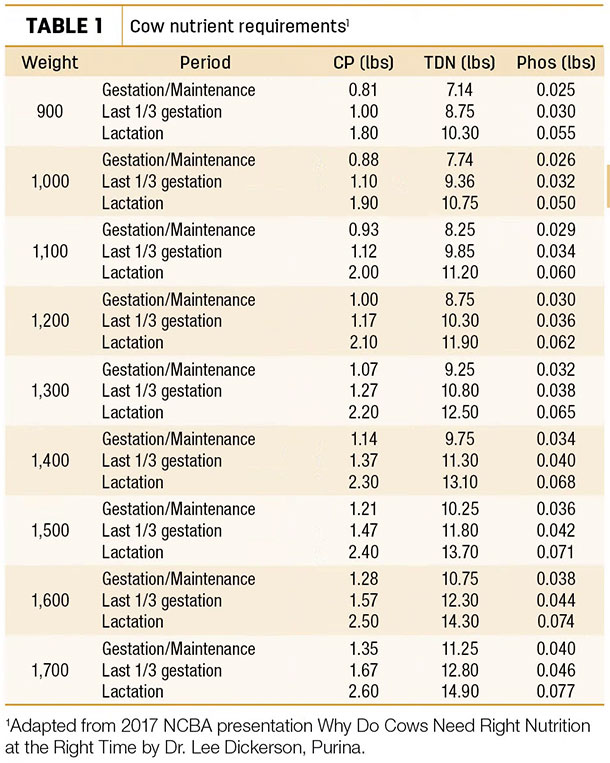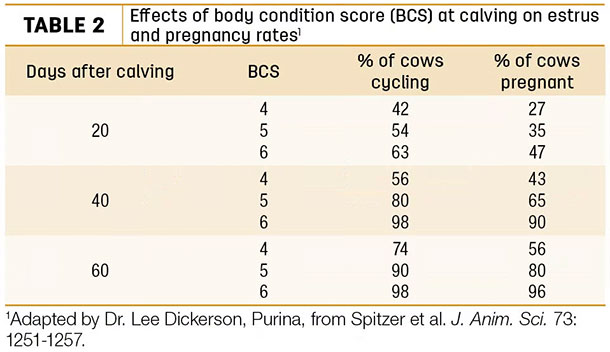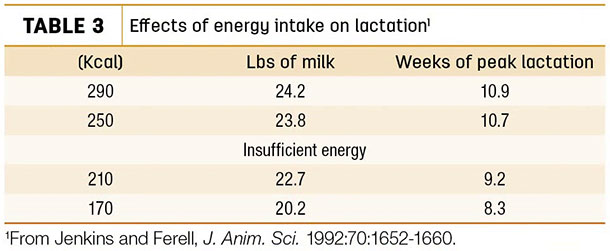Successful ranchers have a production goal of one calf per cow per year. A cow’s gestation period is approximately 280 days, which leaves 85 days in the year for a cow to rebreed after calving (365 – 280 = 85).
There are very few days a cow is without a calf, considering the cow nurses offspring during most of its pregnancy and is rebred quickly if in the right body condition. In reality, a cow giving birth every 365 days is never just feeding itself.
Obstacles and challenges to optimizing performance and returns from a cow are:
- Increasing cow nutritional requirements
- Declining forage quality and intake
- Taking care of the current and subsequent calves
The cow’s requirements
The cow’s nutritional needs are listed in Table 1 by animal weight and production stage. Data in Table 1 show larger cattle require more crude protein, energy or total digestible nutrients and phosphorus than smaller cattle.

It is also shown that the least amount of nutrients is required during the maintenance/early gestation period. Nutrient requirements increase as a cow progresses into the third trimester of gestation, and requirements are the greatest during lactation.
Cow body condition is extremely important for optimal calf production. “Target beef cattle body condition scores [BCS] by production stage,” recommended Dickerson. “At calving, a cow or first-calf heifer should have a 6 BCS. When bulls are put in the herd, cows should have a BCS between 5.5 and 6.0. Bulls should be at a 6 at this time. Cows are expected to lose BCS during lactation, but at weaning they should have a BCS of 5 or greater.”
Significance of BCS at calving on estrus and pregnancy rates are shown in Table 2. Forty days after calving, 98 percent of the cows in BCS of 6 at calving showed heat with a conception rate of 90 percent.

By comparison, cows with BCS of 5 only had 80 percent showing heat and a conception rate of 65 percent.
Second, as shown in Table 3, energy intake has an effect on amount and length of lactation. Daily energy intake of fewer than 250 kilocalories per pound of metabolic bodyweight is insufficient for optimizing amount of milk production and weeks of peak lactation.

Profitable ranchers build their cattle nutrition programs around a good forage base, but they realize forage quality varies throughout the year. In the vegetative stage, native forage has a high moisture content and is all leaf material. It contains 10 to 18 percent crude protein, 54 to 65 percent total digestible nutrients and 0.15 to 0.25 percent phosphorus. As the vegetation begins to form stems and seedheads, the quality changes from good to fair.
Fair-quality forage contains 6 to 9 percent protein, 44 to 53 percent total digestible nutrients and 0.9 to 0.14 percent phosphorus. Mature native forage is poor-quality and is composed of mostly stems and seedheads with very little leaf material. Crude protein is 5 percent or less.
A cow normally eats 2.3 to 3 percent of its bodyweight, on a dry matter basis, when forage quality is good. The cow’s intake will decrease to between 1.3 and 1.8 percent when quality is poor. On poor-quality forage, the rumen bugs don’t get the nutrition they need. Both the number of microbes to digest the forage and their digestion efficiency is reduced. Total forage intake and digestion is then compromised.
Fetal programing
Lifetime performance of an animal is influenced by events occurring before its birth. Positive and negative results are created for the progeny during pregnancy, so maternal environment is important. “How we take care of mama” makes a difference in the life of a calf.
Fetal programing refers to maternal events during development of the fetus that have lifetime effects on the calf after birth. Each trimester of pregnancy appears to play a critical role in proper fetus development.
A brood cow may be the only managed livestock species where the industry plans on weight loss during gestation. They may lose condition during the period that forage first begins active growth following dormancy, during drought and during winter when forage is dormant. “Maternal hunger” is the norm on some ranches.
In the first trimester of gestation, an embryo and fetus are very small – 3/8-inch-long at 30 days. At 45 days, the fetus is 1 inch long and, at 72 days, it is 4 inches. Regardless of fetus size, proper nutrition during the first trimester is critical. During this period, the placenta forms and develops to provide a bed for the fetus.
Blood vessels form and feed the fetus. If the placenta doesn’t develop properly, the calf is at risk. Improper development of organs and limbs during this period may cause health problems at birth.
The second trimester is important for muscle tissue development, which has an effect on future gain and carcass weight. All muscle cells the calf will ever develop will occur prior to birth, so how we take care of the mama cow and its fetus are extremely important. Organs that support muscle growth and calf health are also developing during this period.
Third-trimester nutrition is important beyond weight gain. Seventy-five percent of fetal growth occurs during this period, and final development of the lungs occurs. Nutrition during this phase has a direct influence on respiratory health.
Research studies
Influence of first-trimester gestational nutrition was reported in 2013. Crossbred heifers and sexed semen were used in the study. One group of heifers was provided with 100 percent of the required amount of nutrients, whereas the second group received only 60 percent of their requirements during the first 120 days of gestation.
During the second and third trimesters, all heifers received 100 percent of their nutritional requirements.
Results of restricted first-trimester gestation nutrition were lower weight and body condition in the cows. Restricted-diet heifers had a higher level of circulating testosterone for the first 110 days of gestation. Offspring from restricted-diet cows had enlarged aortas, high arterial blood pressure and reduced ovarian reserves.
Ovarian reserve during the cow’s life is influenced by nutrition to the cow and to a heifer calf in utero. This affects capacity of the ovary to provide egg cells capable of fertilization that result in a healthy and successful pregnancy. Low ovarian reserves cause poor responsiveness to superovulation, reduced levels of circulating progesterone and diminished growth in the uterus during estrus cycle.
The second trimester of pregnancy is also important. Researchers studied the influence of mid-gestation nutrition (120 to 180 days) and reported the results in 2010. During the first and third trimesters, all cows were on native range. For mid-gestation, half of the cows were moved onto improved pasture for the 60-day grazing period.
Weaning weights of calves whose dams were on improved pasture averaged 564 pounds compared to average weaning weights of 533 pounds for calves whose dams stayed on native pasture. The difference in average weaning weights of the two groups was 31 pounds. In addition to heavier weaning weights, calves from the cows on the better nutrition program had more gain at finishing, improved marbling and improved tenderness.
A study reported in 2006 compared calves from cows on supplement during the third trimester (last 90 days) with those from cows with no supplement. Finishing weights of calves from supplemented cows averaged 1,360 pounds, while calves from the unsupplemented group averaged 1,329 pounds. Quality grades were also higher on calves from supplemented dams.
Providing the right nutrition at the right time to the cow herd provides dividends in higher calf weight gains, improved calf carcass quality, better cattle health and increased reproduction percentages. Effective, timely nutrition for the cow and its fetus helps to properly program calves “to be all they can be.” ![]()
PHOTO: Green forage is usually nutritious. Photo by Robert Fears.
Robert Fears is a freelance writer based in Georgetown, Texas. Email Robert Fears.








